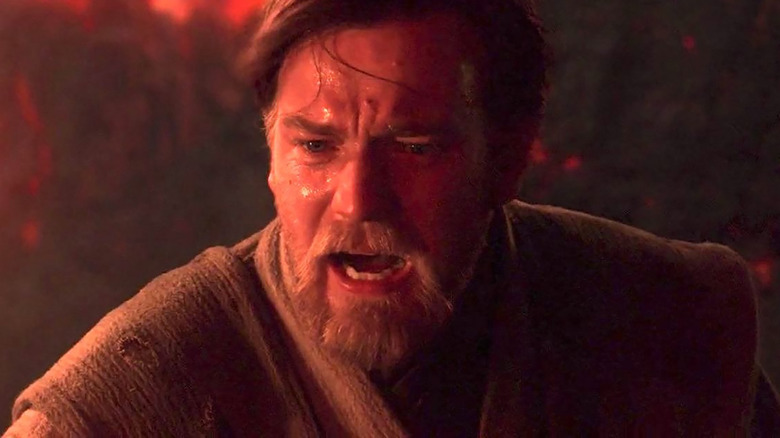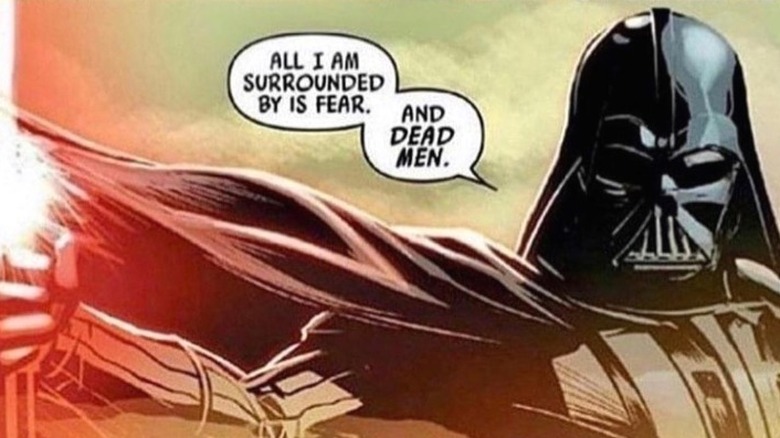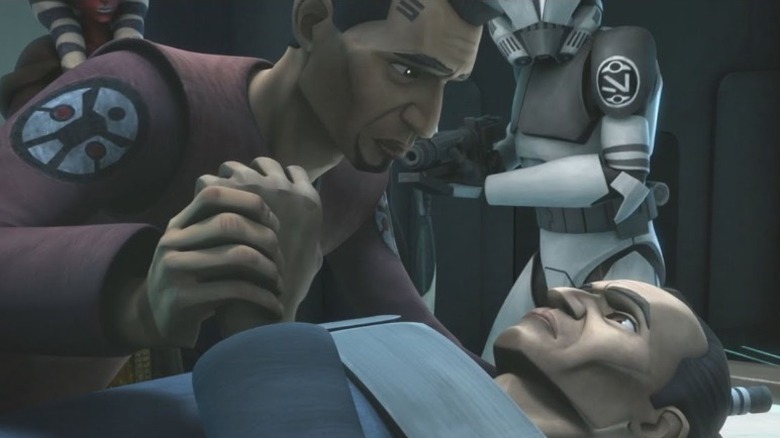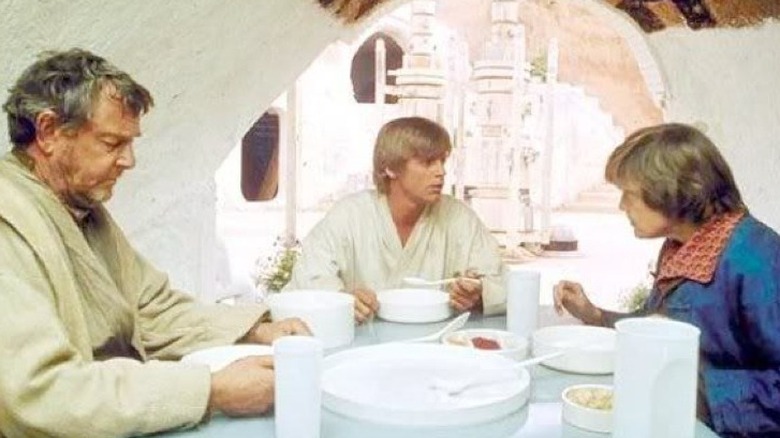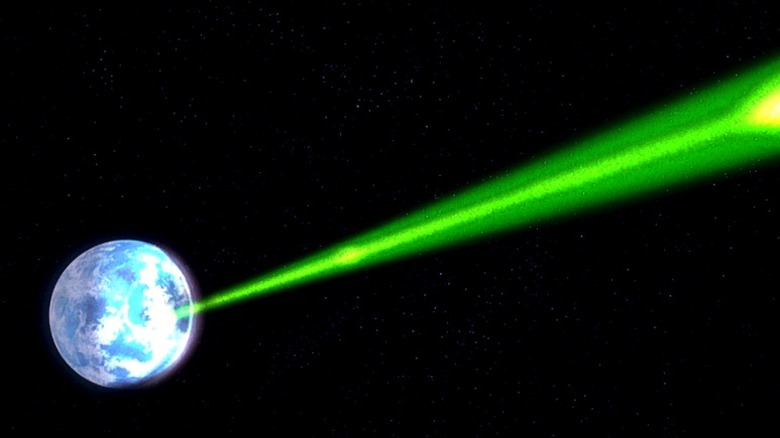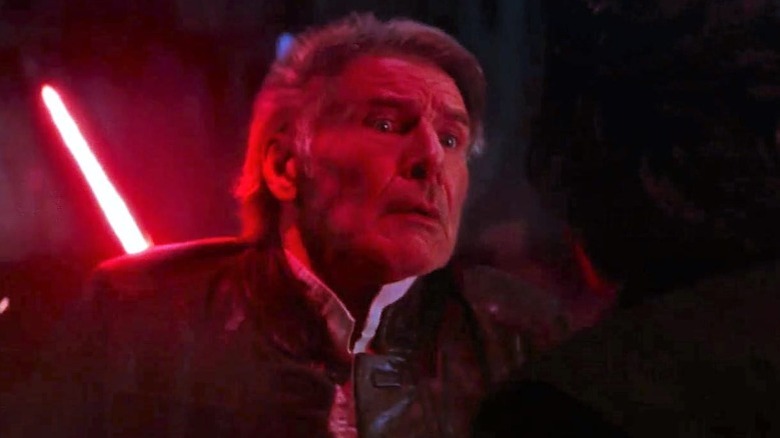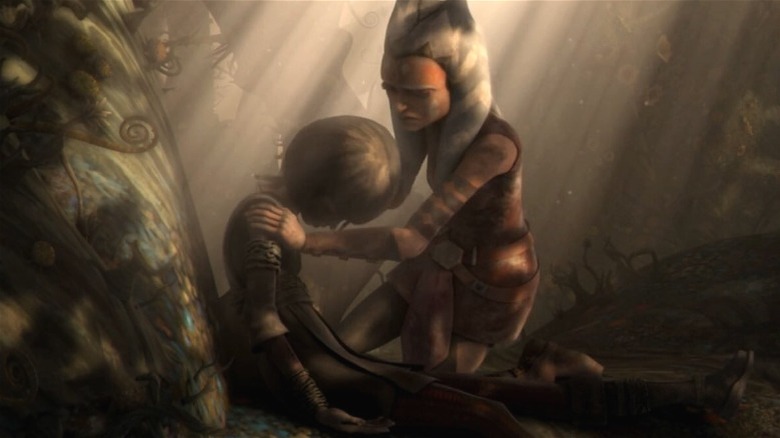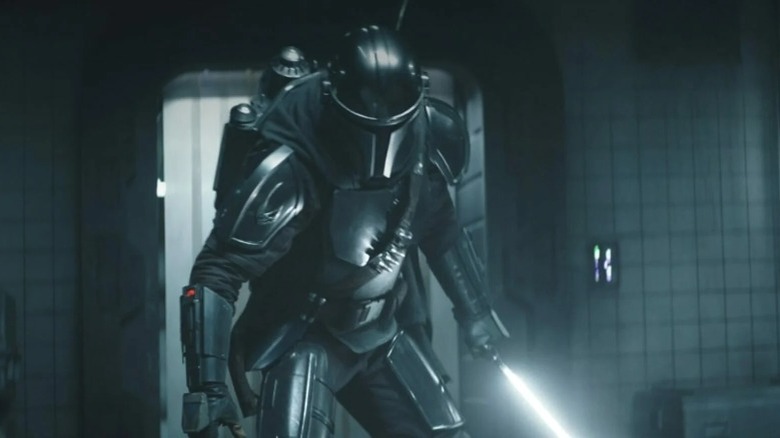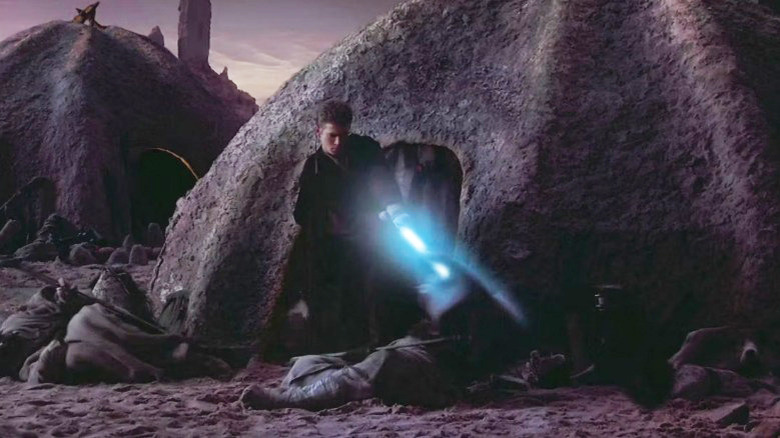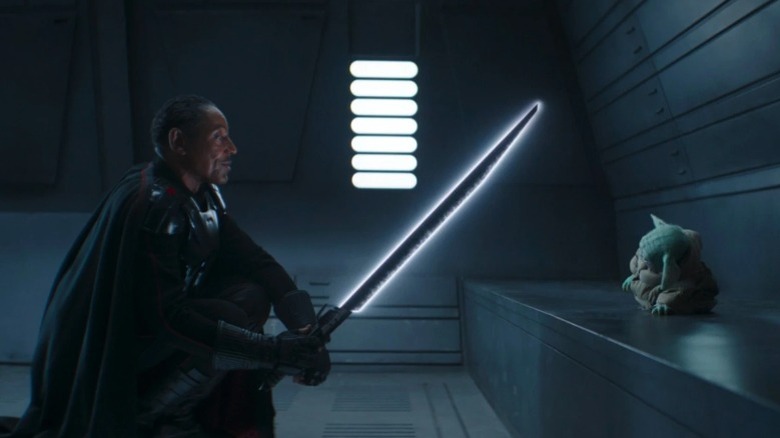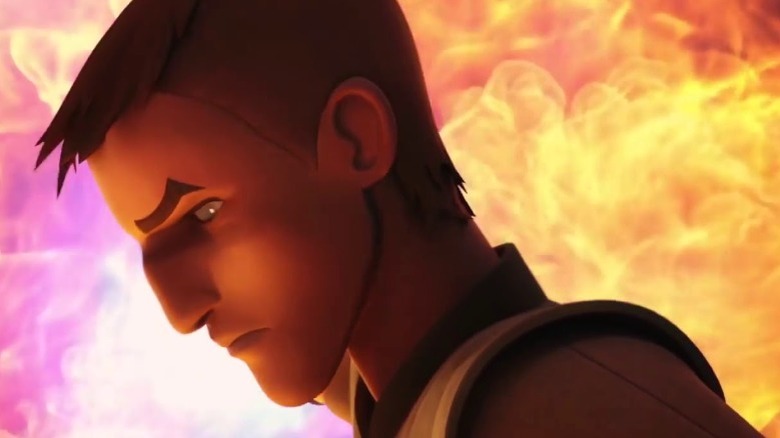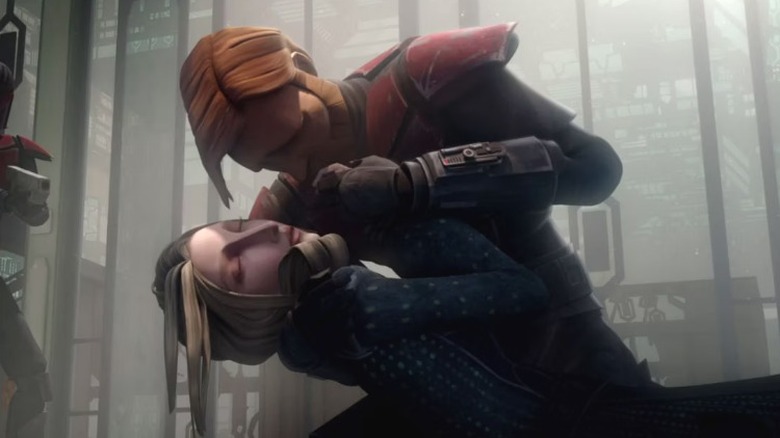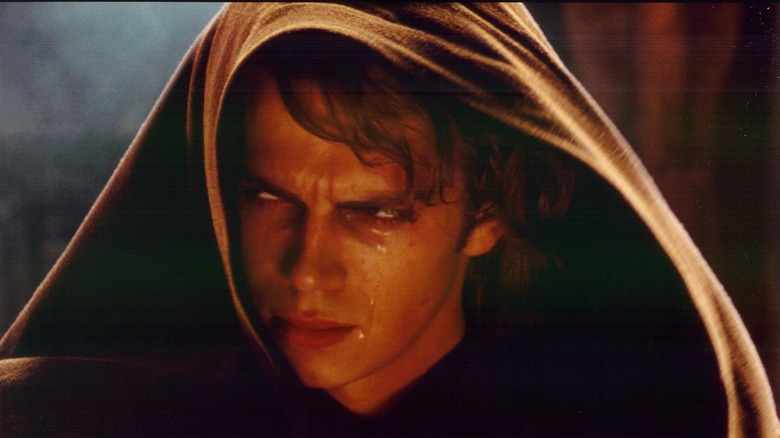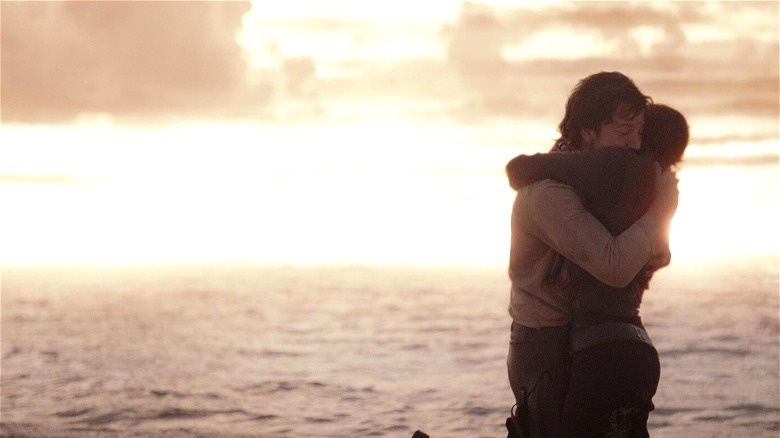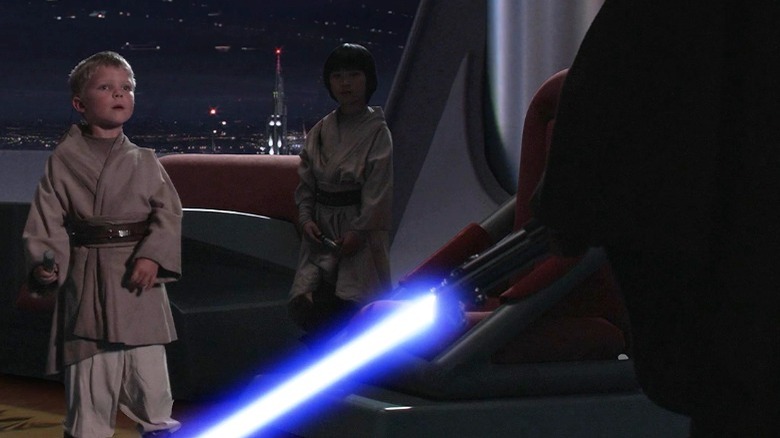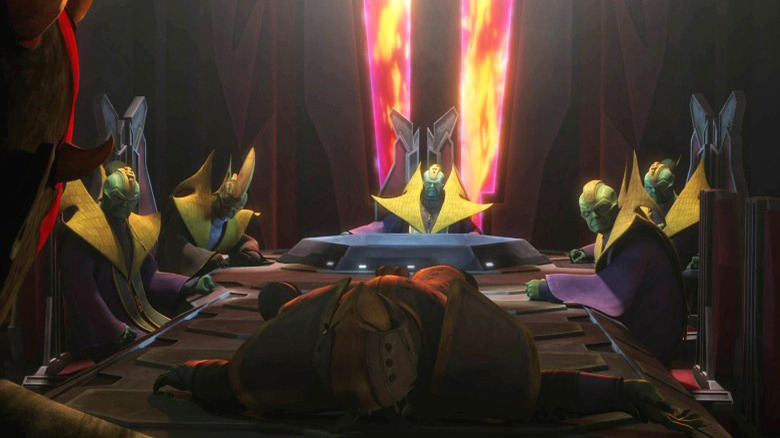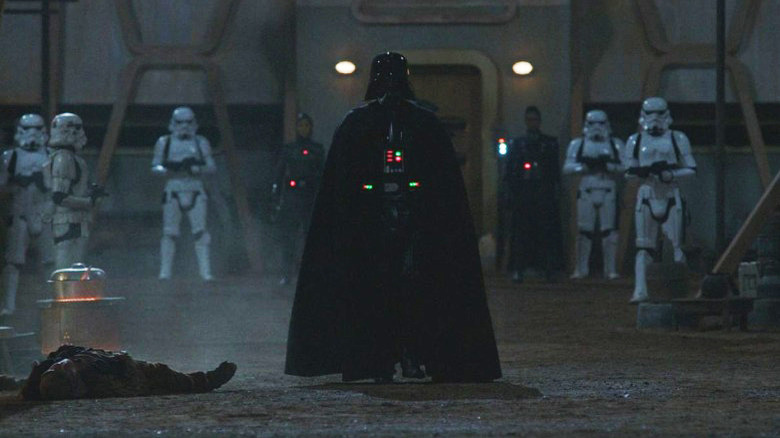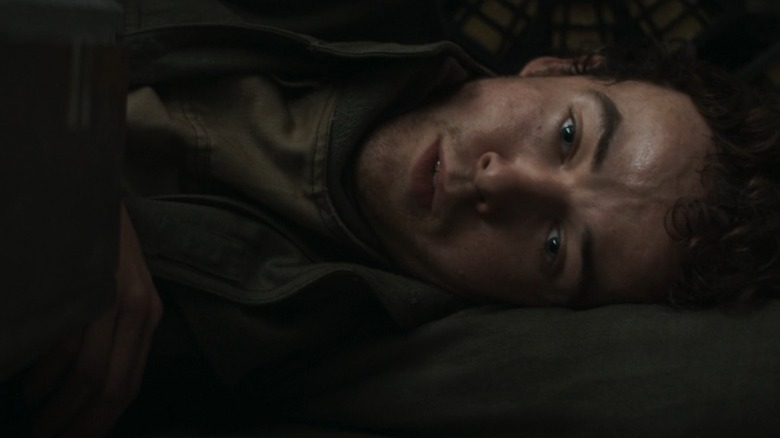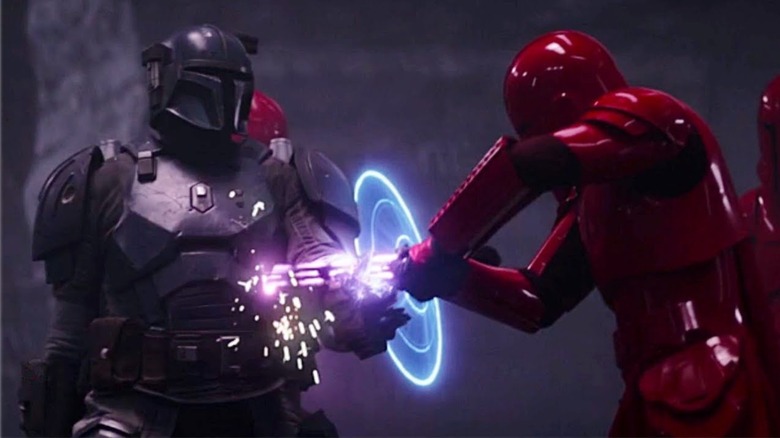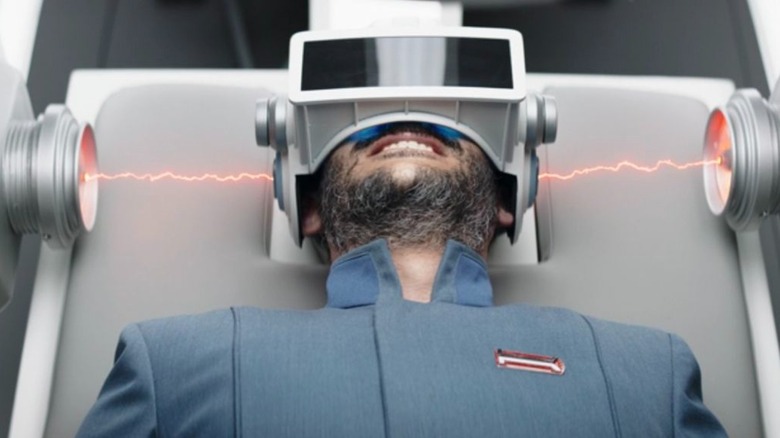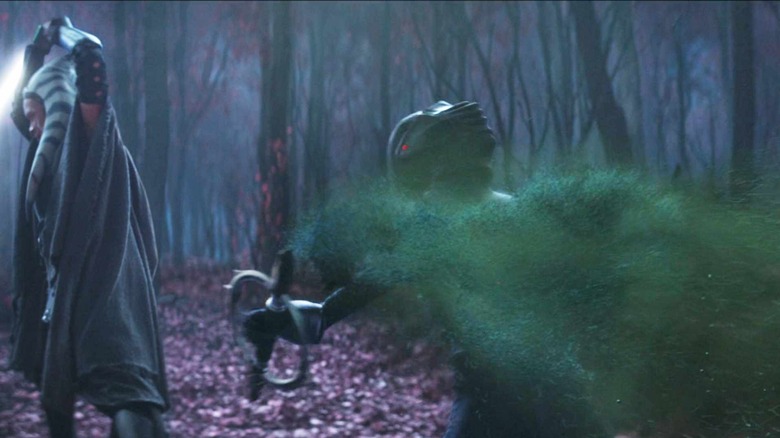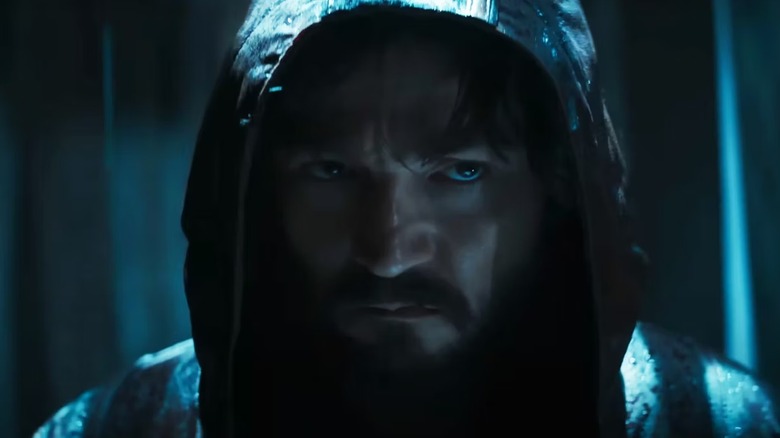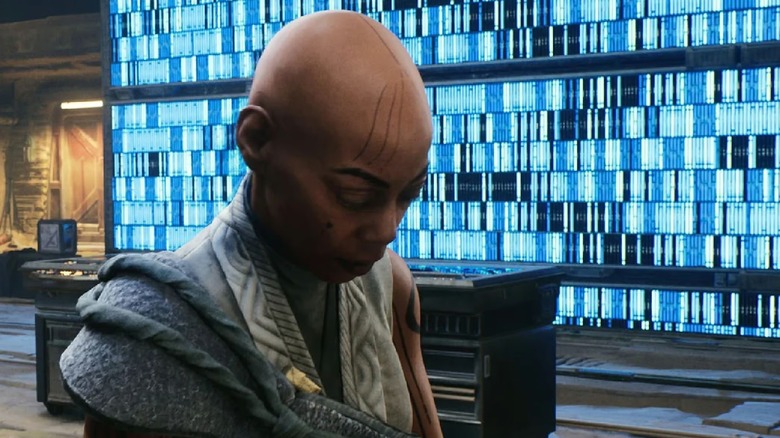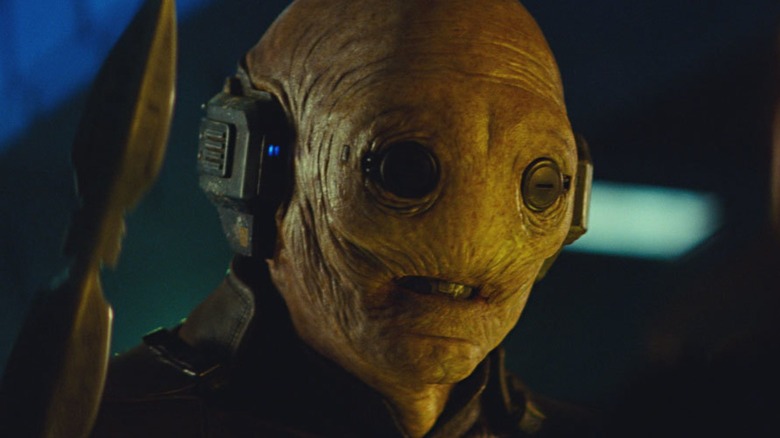The Most Brutal Moments In The Star Wars Franchise, Ranked
In 1977, George Lucas brought "Star Wars" to life. The family-friendly franchise colored its worldbuilding with space western elements and a galaxy of simple good and evil. But a grayer nuance began creeping in by the close of "Return of the Jedi," asking if evil could be redeemed and if scoundrels could be heroes. Lucas seldom lost sight of his intended audience of younger viewers, and these big questions were softened by creatures like the Ewoks and the too cuddly to ever be scary Chewbacca.
Yet, years later, that good intention has sometimes gone sideways. "Star Wars" remains a fun franchise, but it also doesn't shy away from the dark side of war. Even the most kid-friendly spinoffs, such as "The Clone Wars" and "Rebels," can hold some truly disturbing scenes. These are 23 of the most brutal moments in "Star Wars," with a little honorable mention for the galaxy beyond the camera.
23. Star Wars goes hard
Comics, games, and tie-in novels aren't safe places in this galaxy, either. A number of terrifying moments await, like the violence coming off the pages of "Vader Down" by Kieron Gillen and Jason Aaron. It's the moment Vader is on his own, surrounded by Rebel forces. "All I am surrounded by is fear. And dead men," is a promise Vader fulfills. Additionally, gamers familiar with "The Force Unleashed II" might imagine Vader's assault the easiest, since it's the only game thus far to let players hack Stormtroopers into pieces with their lightsaber.
Meanwhile, Luke Skywalker's every encounter with Darth Caedus (his nephew, Jacen Solo, who turned to the Dark Side) in "The Legacy of the Force" turns into an agonizing brawl. Caedus himself accidentally awakens an actual Lovecraftian horror in Abeloth, the original Mother to the Mortis trio that re-entered canon in "The Clone Wars." Sadly, "Vector Prime" by R. A. Salvatore is the first time "Star Wars" fans see an original character die when Chewbacca sacrifices himself. And darkest yet could be Joe Schreiber's "Death Troopers," a zombie horror novel that's only softened by the arrival of two plot-armored faves.
22. Fives' failure (The Clone Wars)
Late in "The Clone Wars," Clone Arc Trooper Fives is watching over Tup, who went rogue and killed the Jedi he was serving with. Lost in a fugue and muttering the phrase "good soldiers follow orders," Tup does regain himself after being hijacked by Separatists, but only for moments before dying on Kamino. Yet something about all this doesn't feel right to Fives, who comes dangerously close to understanding what's behind the "tumor" the Kaminoans are blaming Tup's actions on, and Sidious himself steps in.
Fives pieces together nearly the entire conspiracy behind Order 66 during his four-episode arc in Season 6. Unfortunately, viewers know that Fives is doomed to fail in his efforts to stop it. Palpatine's manipulations are too much for Fives, and the trooper is brought down by his fellow troops. The only comfort in this wrenching arc is that Fives' tragedy is the key to saving Rex's life, and those of the Bad Batch, after the horror of Order 66 is in full swing.
21. Uncle Owen and Aunt Beru die (A New Hope)
Think back to the first time you watched "A New Hope." The boyish pluck of Luke, the scary encounter with the Tuskens, weird old Ben. Then, as the hero's journey spins into action, Luke wants to make sure his aunt and uncle will be okay while he goes off with the former Jedi. And they're not.
It's a brief but heart-rending scene. The setting suns of Tatooine gleaming over the smoldering corpses of Owen and Beru, in front of his childhood home, as Luke freezes in agony. As shocking as it was then, it's even more poignant now. This grumpy, loving pair almost certainly went down fighting the stormtroopers with just as much grit as they showed Reva in "Obi-Wan Kenobi." And for the same reason, to protect a young man with a big future ahead of him. It's the moment Luke knows he can't turn back.
20. The destruction of Alderaan (A New Hope)
Alderaan was a noun at first, a blend of vowels that elicited the idea of some exotic new world at the end of Luke's journey with Ben Kenobi and Han Solo. To Princess Leia, it meant home, and she'd done what she could to try and save it. But the Death Star ran its test, and for decades, all fans ever saw of Alderaan was the jumble of space debris left behind.
Today we know what Alderaan meant to the galaxy. It was a lush, metropolitan world, a place where diplomacy could still work in the favor of ordinary people. The Organa family stood strong throughout the rise of the Empire, known for its ties to the Rebellion, untouchable by virtue of political mastery. Bail was a good man who loved his adopted princess more than anything. Now, when you watch the destruction of Alderaan, it's easier to understand what Leia felt on the Death Star, trying her best to save her family. But like Luke, all she has left are the ashes.
19. Han Solo's death (The Force Awakens)
It's long been known that Harrison Ford isn't as attached to Han Solo as the rest of the fandom. As he explained in 2016, he favored a potential redemption equals death arc for the lovable rogue pilot, with Solo's embrace of the Rebellion leading to his exit by the end of "Return of the Jedi." In Ford's words, "His sacrifice for the other characters would lend gravitas and emotional weight." Beyond that, it's harder to tell how true the stories are that he "hates" Han. Regardless, it was a selling point for Ford that Solo wasn't going to make it out of "The Force Awakens" alive.
Han Solo's death provides the weight Ford wanted. Fans can debate the merits of the sequels all they want, but the sight of Han's pained face as he dies by his son's lightsaber is awful. It works in the context of the story being told, but it's no fun for the audience, whose last memorable sight of Solo is with his face lit blood-red. While spoiling this dark twist for others was a common "gag," it didn't lessen the impact of watching this iconic character die.
18. The Trandoshan hunt (The Clone Wars, Padawan Lost)
A motley group with martial skills and training find themselves dropped on an unknown jungle world, where they quickly figure out they're being hunted for bloodsport. No, it's not 2010's hard-R joyride "Predators," it's an episode of a kid's show. Ahsoka and a troupe of Jedi younglings are the prey in this Season 3 episode of "The Clone Wars," and the predators here are the Trandoshans. You know, the aliens with yellow Godzilla heads and a tendency to get into the bounty hunting business.
The Trandoshan Garnac has established a game preserve, and he has fresh targets dropped off regularly. As brutal as it sounds on its face, it gets even worse as one of the Jedi younglings, Kalifa, is fatally shot on-screen. She doesn't die instantly, getting enough time to beg Ahsoka to promise to watch over the other survivors. Then she dies as Ahsoka has to flee from the Trandoshan advance, and the episode ends with the future of the rest of the younglings still in doubt. Fun!
17. Din Djarin's Darksaber bounty (The Book of Boba Fett, The Mandalorian Returns)
Din Djarin didn't ask to have the Darksaber dropped in his lap, but he's stuck with it. As he makes his big appearance in the middle of Boba Fett's story, Din is running bounties to bribe his way back towards what remains of his covert. Din rolls up on a Klatoonian crime boss lurking in the back of a butcher's warehouse, and he makes it clear his mark will be leaving with him.
The crime boss makes his choice, and the fight is brief but brutal. Din breaks out the Darksaber, and he's not great with it. Just like Hell in a Cell '98, the mob boss is broken in half by the might of the black lightsaber, along with the table under him. Part of Din Djarin's leg also takes some damage, now looking like something that the butcher's shop would slice for hoagies. The man needs some expert saber training. But first, that was hard — yet awesome — to watch.
16. The purge of the Tuskens (Attack of the Clones)
Not sure Anakin's problems could have been solved with therapy, but he could have at least tried. Instead, Anakin doesn't take well to the news that his mother is taken by the Tuskens, nor is he thrilled to find her on the edge of death. Shmi takes comfort in her final chance to see Anakin, but Anakin goes feral and wipes out every Tusken in his reach. Yes, that includes the women and the children, too.
It's not hard to be sympathetic to Anakin's rage, but this isn't something a Jedi should do. Fans already knew his fate to come, and it's clear in the vicious satisfaction he feels that Darth Vader is on the cusp of manifesting. What's also ugly knowledge is that, while there's no excuse for what the Tuskens do to their prisoners, it's also a fact that they're a marginalized indigenous culture. Their violence makes at least as much sense to them as Anakin's does to him, a reckoning of justice. But neither heals anything.
15. The taking of Grogu (The Mandalorian, The Tragedy)
Conservatively guessing, about 90% of this late Season 2 episode of a man and his perfect green baby is a soul-killer. The cybernetic third-generation Dark Troopers are now back in canon after their menacing Legends appearances, relentlessly set on grabbing up Grogu for Moff Gideon. Din watches his Razor Crest get blown up just weeks after LEGO fans got their hands on its bricky counterpart. Moff proceeds to personally intimidate the hell out of Grogu, leaving him in the galaxy's tiniest handcuffs.
One of the most feel-bad episodes of "Star Wars" so far, at least it had a few hopeful moments. Boba Fett got to show off his own brutal moves, with Fennec Shand at his side. The audience knows full well that Din is going to go after the kid as soon as he can. But first, the camera has to linger on Grogu, prone and alone and scared, in an Imperial holding cell.
14. The death of Kanan Jarrus (Star Wars: Rebels, Jedi Night)
"Rebels" is no stranger to tough moments. Lothal spends its time under siege, and it's the series that helps Thrawn back to canon. However, it's a different twist of fate that changes the tone of the series. Kanan has been blinded by Darth Maul, but the Force still guides his steps. Unfortunately for Hera and the rest, that guidance led to the moment Kanan knew he'd have to give his life to save theirs. He does it willingly, able to look the love of his life in her eyes one last time as the Living Force claims his soul, and his body disintegrates.
The tragedy of Kanan's loss is nearly insurmountable for the crew of the Ghost. Kanan's sacrifice saves them from Governor Pryce's destructive attempt to end the rebels, but it also strains Ezra Bridger nearly to breaking. It takes Ahsoka Tano, and a white Loth-wolf that seemed to carry Kanan's will inside it, to keep Ezra on his own fateful course towards liberating Lothal.
13. The death of Duchess Satine (The Clone Wars, The Lawless)
Fridging, as a trope, has existed for a long time. Codified by comics writer Gail Simone ("Deadpool"), it's when someone, usually female, gets killed off so audiences can watch a man agonize over it. Like all tropes, it can be badly used, but when done right, the audience learns a lot about the characters involved. When Duchess Satine is killed by Darth Maul during this late Season 5 episode, Satine's love, Obi-Wan Kenobi, is forced to watch.
Maul isn't a merciful guy. He starts by Force-choking the Duchess in an attempt to turn Kenobi to the Dark Side. When that doesn't work, he slowly impales the deposed ruler of Mandalore on the Darksaber. Obi-Wan doesn't break his Jedi oaths, but he's still stricken by emotion as he cradles the dying woman who loved him. It's an effective, heart-wrenching way of showing Kenobi's power, and what it costs him. Years later, when Kenobi executes Maul on the sands of Tatooine, it's with that same Jedi code, and with the mercy Maul never showed.
12. The burning of Anakin (Revenge of the Sith)
In terms of pacing, the prequels are a mess punctuated by stunning sequences and an anthological plot. Somewhere in there is a good story about how the rise of darkness starts in well-meaning hearts. There's a tragedy in the fall of Anakin, and most of it is reflected in the anguish on Obi-Wan's face as he realizes his Padawan has to be stopped by any means necessary.
As the climax of "Revenge of the Sith" hits a crescendo, that realization is literal. Obi-Wan and Anakin are locked in a far-ranging duel across Mustafar's molten lava, fueled by Anakin's rage and Obi-Wan's desperation. In the end, the master wins, but victory means the rarely flappable Kenobi leaving his former apprentice in screaming agony, his limbs burned away, death imminent. Obi-Wan can't bring himself to strike the killing blow, and it's a mistake that will torment both of them for decades. "Obi-Wan Kenobi" showed fans how literal that torment is.
11. The destruction of Scarif (Rogue One)
It's not an urban legend, it's true: "Rogue One" director Gareth Edwards was prepared to give this ground-level war epic "Star Wars" tale a happier ending. Then, Kathleen Kennedy herself asked why shouldn't everyone die by the end? When most of Scarif's tropical surface is boiled away by the Death Star's laser, that includes our remaining protagonists.
There aren't many left by then. "Rogue One" is mostly the tale of Jyn Erso (Felicity Jones), a reluctant rebel, but Cassian Andor (Diego Luna), K-2SO (Alan Tudyk), Chirrut Imwe (Donnie Yen), Baze Malbus (Jiang Wen), and even the nervous Bodhi Rook (Riz Ahmed) have taken over viewers' hearts. As this rag-tag bunch draws closer to finding the Death Star plans and the weakness they hide, they fall, one by one, until it's only Jyn and Andor holding each other, waiting for the end. Technically, Scarif isn't destroyed by the Death Star. Still, with its oceans gone and its surface blasted open, no one could come back from Scarif alive.
10. The youngling slaughter (Revenge of the Sith)
The "fun" thing about how traumatizing it is to watch Anakin Skywalker succumb utterly to the Dark Side and start killing little kids like he's getting a volume discount is the way the franchise gives fans new angles of the mayhem of Order 66 every few years. Not much beats the implication of Anakin, on the cusp of becoming Darth Vader, firing up his lightsaber in front of a round-faced child, though. A harsh contender is Reva's memories, explored during "Obi-Wan Kenobi." They came close enough to create pain for a country shadowed by a grade school massacre, necessitating a warning.
"The Clone Wars" episode "Ghosts of Mortis" showed Anakin a glimpse of his fate, raising his lightsaber at a child. That wouldn't be enough to alter the future, nor Yoda's own premonitions in "Voices" later. Anakin can't change his destiny, creating a tragic nexus event that warped the lives of survivors all across the galaxy. It's necessary, in a sense, but it's almost too awful for its galaxy to bear.
9. The execution of the Black Sun (The Clone Wars, Eminence)
Darth Maul's obsession with Obi-Wan nearly rivals Vader's own passion for revenge. It's his motivation throughout the entirety of his animated appearances, and his murder of Duchess Satine is as close as he can get to tearing out Kenobi's heart. That's not the only savagery Maul commits on the way to his goal, though. In order to raise enough troops, Maul is willing to execute an entire crime syndicate. It's one of the few scenes to be censored during broadcast because heads literally roll.
Maul wants the power of the Black Sun syndicate behind him as he forges his Shadow Collective, the organization that includes Crimson Dawn and the Mandalorian Death Watch. He and his brother, Savage Oppress, meet with the Black Sun's representatives on Mustafar, and when they hesitate to join, Savage snaps the neck of one soldier, then spins his lightsaber across the table, decapitating them all. Save for Zitan Moj, who bends to Maul's will. The scene is uncut on home release and fulfills the implication left in the aired version.
8. Darth Vader's village rampage (Obi-Wan Kenobi)
It's hard to overemphasize how scary Darth Vader was back when "A New Hope" was released. He's a looming figure with a sepulchral voice, storming through the halls of a Rebel ship, capable of killing without a touch. It doesn't get better until later, when the person he once was is revealed in his final, redemptive hour. Eventually, fans met his human side, the young and impulsive Anakin, and it gave audiences maybe too much empathy for the dark lord.
"Rogue One" was the first reminder of what Vader could be, but it was "Obi-Wan Kenobi" that showed Vader's burning rage, and reminded fans of what it felt like when he was a demonic cipher. This is a Vader spilling over with pain from his burns, easing it by inflicting it on whoever's in his way. A small town can't possibly withstand him. Instead, they watch their loved ones choked out by the Force and dragged like garbage through the streets. It's shorter than Vader's original 1977 introduction, but it's much worse now because the violence in him feels so primal.
7. No OSHA compliance and the death of Nemik
Young rebel Karis Nemik (Alex Lawther) seemed like a dead man walking the moment he came on screen. He's an active little dude; idealistic yet optimistic. He likes to spend his downtime scribbling furiously on his in-progress anti-Imperial manifesto. But his fervor is infectious, and Andor clearly likes the kid despite himself. Nemik is just as eager as anyone to pull off the big heist on Aldhani, and as dangerous as the gig is, we expect nearly everyone but Andor to go down during the job. Despite all odds, the heist does go off, but in the last moments, Nemik pays the highest price.
After loading a ship with stolen booty, take-off turns into a frantic affair as Imperials catch on to what's happening. Nemik is in the back with the heavy crates of credits, and the team didn't have the time to secure their winnings before fleeing. Due to launch gravity, Nemik can't get out of the way when the cargo goes sliding. There's something grim to be said about this young man being literally crushed to death by the Empire's capitalistic greed. It's not a quick death, either, and that weight is felt in the gift of Nemik's manifesto, willed to Andor as his final request.
6. The fall of Paz Vizsla
Paz Vizsla (Tait Fletcher in costume, voiced by Jon Favreau) got that "marked for death" feeling in Season 3 of "The Mandalorian," by introducing his son, going through some personal growth, offering his loyalty, etcetera. As the season built to a finale against a too-clever Moff Gideon, we started to hope that, maybe, the last standing member of Clan Vizsla might make it. But nobody expected him to go out the way he did, in a brutal stand-off against some of the very best weapons the Imperial remnants had to offer.
Praetorian Guards are the evolution of the Emperor's red-robed Royal Guards, in both style and skill, and the precursors of both Snoke's and the reanimated Palpatine's own loyalists. Three of them were deployed to Moff Gideon for protection, and it takes all three of them to drop Vizsla after he's already been exhausted by waves of lesser enemies. He holds his own for several bracing minutes until they wear him down like a boar, piercing him to death with their staves. We can't help but root for Vizsla the whole time, hoping for a twist in his fate. Instead, we have to take comfort in how the Mandalorians, all factions, will honor his memory.
5. The betrayal of Dr. Pershing
Not every horror show has to be blatant or gory. Dr. Pershing (Omid Abtahi) was on a timid but well-intentioned journey of redemption after his part in the experimentation on cute little Grogu when "The Mandalorian" started. By Season 3, he's accepted his place in the New Republic's amnesty re-education system, hoping to prove to his hosts that his scientific skills, even the controversial ones that landed him into trouble, could benefit the galaxy.
It's even nice to see him making friends. Unfortunately, the audience twigs fast that Elia Kane (Katy O'Brian) is still as aloof and creepy as she was when serving Moff Gideon. Our suspicions are validated when she hangs Pershing out to dry after she "helps" him retrieve some science equipment from a scuttled Imperial ship. And somehow it still gets worse. Pershing is subjected to a form of shock treatment to readjust his thinking — never okay, even when the Republic does it — but when a med tech foolishly leaves Kane alone in the control room, she yanks the knob up to 11. Pershing displays visible agony as his memories of everything he's done for Moff Gideon and the Empire turn into guacamole. Yikes.
4. The end of Marrok
"Ahsoka" has already shown off its return to the "Star Wars" origin stories of legendary samurai, calling back to Zatoichi the Blind Swordsman in its second episode. In the third, it's Akira Kurosawa — director of "Star Wars" predecessor and inspiration "The Hidden Fortress" — who gets the nod. "Sanjuro," a sequel to "Yojimbo," isn't as well known. But it's the origin of one of the most notable special effects in movie history: the over-the-top blood spray.
In episode 3, Ahsoka faces Marrok, a fallen Jedi with no known identity save for being a probable former Inquisitor. The setup for their final duel may look like the last time Obi-Wan fights Darth Maul, but it's paced and pays off the same way as that climactic duel in "Sanjuro." Ahsoka and Marrok assess each other in silence. Then they each take one slice, and Ahsoka tears him open through his chest. Instead of ghastly amounts of blood, Marrok begins to disintegrate from the inside. It's not clear if that makes him a Nightsister zombie or what, but the effect feels unsettlingly final!
3. Andor kills without hesitation
"Star Wars" remains a family friendly affair, but "Rogue One: A Star Wars Story" showed us it was possible to go to some darker places and stay hopeful. "Andor" tunnels down harder on this motif, pushing the limits of kid-friendly while still believing in the Light Side. This series made its intentions clear as the episode opened, introducing us to a protagonist who immediately does something no hero in "Star Wars" has done before.
Cassian Andor (Diego Luna) relentlessly searches for his family, and his intensity draws the eyes of some local space cops. They're drunk and stupid, and things get out of hand fast. The death of the first cop is an accident, but it also means Andor must make a quick calculation about his odds of future survival. The result is functionally an assassination, as Andor shoots the other grunt in the head, on screen. Not only does it bring Andor the attention he never wanted, but it prepares us for another quick decision Andor makes in episode six. He makes the same calculation under duress, killing Skeen (Ebon Moss-Bachrach) before Skeen can kill him. Dark stuff, even if for good causes.
2. The death of Cere Junda
Fans joined Cal Kestis and the crew of the Stinger Mantis as they tried to save the future of a devastated society in "Star Wars Jedi: Fallen Order." It was a journey that saw Cal's companions evolve and grow a lot, from one of the last Dathomirian Nightsisters, Merrin, to the rogue Jedi Knight, Cere Junda. It was a relief to have them back in "Star Wars Jedi: Survivor," but the feeling turns bittersweet by the end.
Not only does the game end with the same gloomy heaviness as "The Empire Strikes Back," but fans of the games remember what it was like to survive Lord Vader's onslaught in the climax of the first game. No prizes for guessing that he'd be back, but this time, players are forced to fend him off as Cere, not as Cal — and "winning" the fight only means that Cere bought crucial time for others to survive. Vader is as merciless as he was in "Obi-Wan Kenobi," and watching him impale Cere with his lightsaber, at the height of her renewed path through the Force, hurts so deeply that we end up empathizing with Cal's dark decisions afterward.
1. The Last Days of Ochi
Remember Ochi of Bestoon? Of course not. He's that dead Sith guy they found in the sand in "The Rise of Skywalker." You know, the one that had the dagger that just happened to lead to where our heroes needed to go by the end? Still no? We get it. Anyway, "Shadow of the Sith" by Adam Christopher is a canon novel that tries to untangle what was going on with all this, and does the job of righting the wrongs pretty dang well. Ochi spends the bulk of the novel doing a Terminator-style hunt for Rey's parents, while also going slightly mad from Sith influence.
In the novel's final pages, we learn the grisly details of how he succeeded. It's painful stuff, with Dathan, the doomed Palpatine clone, and Miramir, Rey's mother, knowing they're giving up their lives for Rey. He kills Dathan first, and all we know of Miramir is that she fights to the end. Their gambit works, and Ochi travels to the desert world Pasaana, where their ghosts drive him to total madness, and he dies, strangled by the shifting sands. It's a vast upgrade to what we're given in the novels, giving Rey's survival greater impact.
